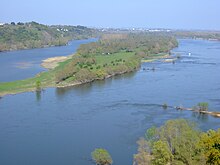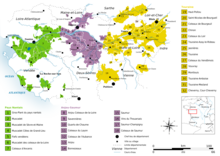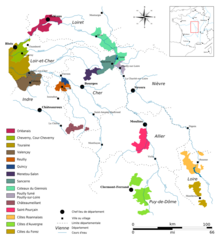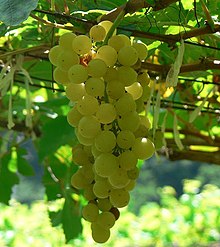Loire Valley (wine)
| Wine produced | Still, sparkling wine, dessert wine, rosé |
|---|---|
The Loire Valley wine region includes the
History
Climate and geography

The Loire river has a significant effect on the
Temperature, rainfall and average sunshine time in
| Month | Jan | Feb | March | Apr | May | June | July | Aug | Sept | Oct | Nov | Dec | Year |
|---|---|---|---|---|---|---|---|---|---|---|---|---|---|
| Average minimum temperature (°C) | 2,1 | 2,2 | 3,9 | 5,6 | 8,9 | 11,8 | 13,6 | 13,4 | 11,3 | 8,4 | 4,6 | 2,8 | 7,4 |
| Average temperature (°C) | 5 | 5,7 | 8,2 | 10.4 | 13,9 | 16,2 | 19,2 | 19,1 | 16,5 | 12,7 | 8 | 5,6 | 11,8 |
| Average maximum temperature (°C) | 7,9 | 9,2 | 12,6 | 15,3 | 19 | 22,6 | 24,9 | 24,7 | 21,8 | 17 | 11,4 | 8,4 | 16,2 |
| Average monthly rainfall (mm) | 62,1 | 50,8 | 51,7 | 44,6 | 54,4 | 41,2 | 43,8 | 44,9 | 52,2 | 59,6 | 64,5 | 63,4 | 633,4 |
| Monthly hours of sunshine (hour/month) | 70 | 92 | 141 | 179 | 201 | 234 | 248 | 237 | 191 | 129 | 89 | 65 | 1877 |
| Source : Climatology from 1947 to 2008 - Angers, France | |||||||||||||
Viticulture and winemaking

With over 185,000 acres (750 km2) planted under vine, the Loire Valley is about two-thirds the size of the
The Loire Valley has a high
Winemaking in the Loire is characterised by a general avoidance of
Wine regions


The Loire Valley is often divided into three sections. The Upper Loire includes the Sauvignon blanc dominated areas of
Sancerre & Pouilly-Fumé

Sauvignon blanc and Pinot noir are the principal grapes of this region that is centered around the appellation of Sancerre and Pouilly-Fumé. The two towns of Sancerre and Pouilly-sur-Loire (where Pouilly-Fumé is made) sit on opposite sides of the Loire river with Sancerre being about 10 miles (16 km) to the northwest of Pouilly. The Fumé is said to come from the silex flint interspersed with the limestone in the area that can give a smoky gunflint note to the wine. Another possibility for the name is the early morning fog created by the Loire river that can blanket the vineyards. Wines labeled with just Pouilly or Pouilly-sur-Loire are often made from the Chasselas grape.[6]
Unlike many areas of France, the Sancerre region is heavily mechanized with the use of
- Menetou-Salon - White, red and rosé
- Quincy - White wine
- Reuilly - White, red and rosé
The region was under the influence of the Duchy of Burgundy for most of its history which partly the reason why plantings were once heavily dominated by the Pinot noir grape. The Phylloxera epidemic of the 19th century altered that dynamic when many of the Pinot noir vineyards were wiped out by the louse. In their place, plantings of the easier to cultivate Sauvignon blanc vine began to increase. While there are still isolated batches of Pinot noir in the region, Sauvignon blanc is now the most heavily planted.[8]
Anjou-Saumur

The Anjou region of the Middle Loire is situated around the town of
The area around Saumur is the third largest sparkling wine appellation in France after the Champagne region and the
Vouvray and Touraine

The region around Vouvray,
For years the Touraine region would compete with the
Chinon

The area around Chinon,
Muscadet
The Muscadet region is located at the westernmost edge of the Loire Valley near the city of
- Muscadet-Sèvre et Maine
- Muscadet-Côtes de Grand Lieu
- Muscadet-Coteaux de la Loire
- Muscadet- A generic appellation covering the whole of the Loire-Atlantique department.
The wines of the Muscadet-Sèvre et Maine and Muscadet-Côtes de Grand Lieu appellation are often bottled

The white wines of the Coteaux du Layon, Montlouis-sur-Loire, Savennières, and Vouvray are based on Chenin blanc and are known for their high acidity when young and ability to develop and age well. The villages of Sancerre and Pouilly-sur-Loire are known for their crisp and herbaceous Sauvignon blancs. Some producers in the area are experimenting with oak aging their Sauvignon blanc to give them more rounder and softer appeal. The villages of Bourgueil, Chinon and Saumur are known for their Cabernet franc based wines that range from light and fruity in Saumur to rich and velvety in Chinon. The Muscadet wines from the Pays de la Loire are made from the Melon de Bourgogne grape and are known for their citrus and mineral notes.[2]
In addition to the main production grapes, several local grapes are also used to make wine in smaller quantities. These include the
A characteristic of many Loire wines (both red and white) is the high acidity which highlights the fresh, crisp flavors of their youth only to go through a "dumb phase" between 2 and 5 years of age when the wines flavors are drastically toned down. Many of the better made examples come out of this period with their full palate of flavors and can continue to age well into 20 years. Some of the Sauvignon blanc based wines like Sancerre buck this trend and instead stay more low key till their third year when they mature and develop their full assortment of flavors before they eventually fade around their 7-10th year. However the best made examples in top vintages can often live much longer.[2] Some classic examples of Vouvray can even reach the levels of longevity commonly associated with Port.[12]
Wineries
Historically the wineries of the Loire Valley have been small, family owned operations that do a lot of estate bottling. The mid-1990s saw an increase in the number of
References
- ISBN 0-7566-1324-8
- ^ ISBN 1-74048-050-3
- ^ ISBN 0-19-860990-6
- ^ ISBN 1-56305-434-5
- ^ ISBN 0-7892-0883-0
- ISBN 1-84000-332-4
- ^ Molesworth, James (18 September 2008). "Didier Dagueneau Dies in Aircraft Crash at 52". Wine Spectator. Retrieved 4 June 2013.
Didier Dagueneau, whose piercingly pure wines helped set a new standard of excellence for the Loire's Pouilly-Fumé appellation, was killed Wednesday when the ultralight aircraft he was piloting experienced trouble on takeoff, and crashed.
- ISBN 0-7566-1324-8
- ISBN 0-7566-1324-8
- ISBN 1-84000-332-4
- ISBN 0-7566-1324-8
- ISBN 1-84000-332-4
External links
- Official Site of Loire Valley wines
- Map of the Loire Valley wine regions
- Loire Valley vintage charts
- The wines of the Loire - The official website of France (in English)
